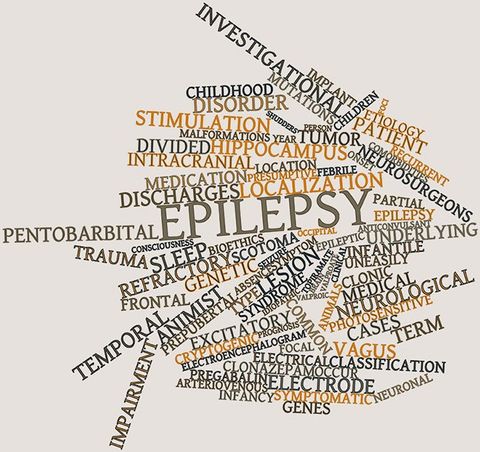Epilepsy Facts and FAQ's
- What is epilepsy?
The word "epilepsy" comes from the Greek word for "seizure."
Epilepsy is a controllable condition caused by abnormal electrical activity in the brain resulting in temporary seizures.
It is not a disease!
Epilepsy is actually an umbrella term covering about 20 different types of seizure disorders.
- What are seizures?
A seizure is a disturbance in the electrical activity of the brain. 25 million Americans (1 in 10) have had, or will have, at least one seizure at some time in their lives.
Seizures may include muscle spasms, mental confusion, a loss of consciousness and/or uncontrolled or aimless body movements. There are two main types of seizures:
- Generalized - begin with a discharge of neurons throughout the brain. They include:
-- Tonic-Clonic seizures or “grand mal” (loss of consciousness, stiffening of body, jerking of limbs)
-- Absence seizures or “petit mal” (blank spells, staring, slight twitching)
- Partial - begin with a discharge of neurons in just one part of the brain. They include:
-- Simple Partial seizures (uncontrolled body movements, brief changes in sensory perceptions)
-- Complex Partial seizures (confusion, loss of awareness, aimless movements)
-- Infantile Spasms (babies have sudden, jerking seizures)
- There are many less common types of seizures.
- Seizures may be frequent or rare. They may last a second or several minutes. They may be severe or mild.
- A person can have more than one type of seizure, and the pattern of seizures may change with time.
- What causes epilepsy?
In about 70 percent of cases there is no known cause. But we do know that recurring seizures can be related to:
- Head trauma: especially from automobile accidents, falls and/or blows, gunshot wounds or sports accidents. The more severe the injury, the greater the risk of developing epilepsy.
- Infection: meningitis, viral encephalitis, and less frequently: mumps, measles, diphtheria and others.
- Brain tumor and strokes
- Poisoning: such as lead or alcohol poisoning. More than 5,000 persons each year are reported to suffer seizures caused by alcoholism.
- Maternal injury, infection or systemic illness: affecting the developing brain of the fetus during pregnancy.
- At what age does epilepsy start? Is it hereditary?
- Epilepsy primarily affects children and young adults, although anyone can get epilepsy at anytime.
- 20% of cases develop before the age of five, and 50% develop before the age of 25.
- However, epilepsy is also increasingly associated with the elderly, and there are as many cases in those 60 years of age & older as in children 10 years of age & under.
- Heredity usually is not a direct factor in epilepsy. But some kinds of brain wave patterns associated with seizures do tend to run in families.
- How is epilepsy diagnosed?
- Medical History: the physician asks for a detailed description of the seizures, as well as family and personal health histories (including pregnancy, birth and development).
- Physical Exam & Lab Tests: a complete physical is done to determine whether the seizures are caused by a specific physical or metabolic problems.
- Neurological Exam: this includes a thorough study of the nervous system. An EEG (electroencephalogram) may help identify any abnormal electrical activity in the brain. CT or MRI scans may be used to examine the internal structure of the brain.
- How is epilepsy treated?
Most seizure disorders can be controlled partly or completely by:
- Anti-convulsive medication
- Surgery
- Diet
- How can I help someone who is having a seizure?
- Stay calm: don't try to restrain or revive the person. If the person is seated, help ease him/her to the floor.
- Remove hazards such as hard or sharp objects that could cause injury if the person falls or knocks against them.
- Don't move the person unless the area is clearly dangerous, such as a busy street.
- Loosen tight clothing and remove glasses.
- Protect airways by gently turning the person on one side so any fluid in the mouth can drain safely.
- Never try to force something into the person's mouth!
- Don't call an ambulance unless the seizure lasts more than five minutes, or is immediately followed by another one, or if the person is pregnant, ill, or injured.
- When the seizure ends, let the person rest or sleep. Be calm and reassuring because the person may feel disoriented or embarrassed.

Let's talk about epilepsy!
Contact Info
Address
:
688 E. Main St. Salisbury, MD 21804
E-mail: contact@UNA1.org
Toll Free Phone : 1-800-776-5694
Local Phone: 410-543-0665
Fax:
410-543-0432
To discuss employment opportunities in Cecil, Talbot, Kent, Dorchester, Worcester, please call: Heather Snell. (EXT. #103)



